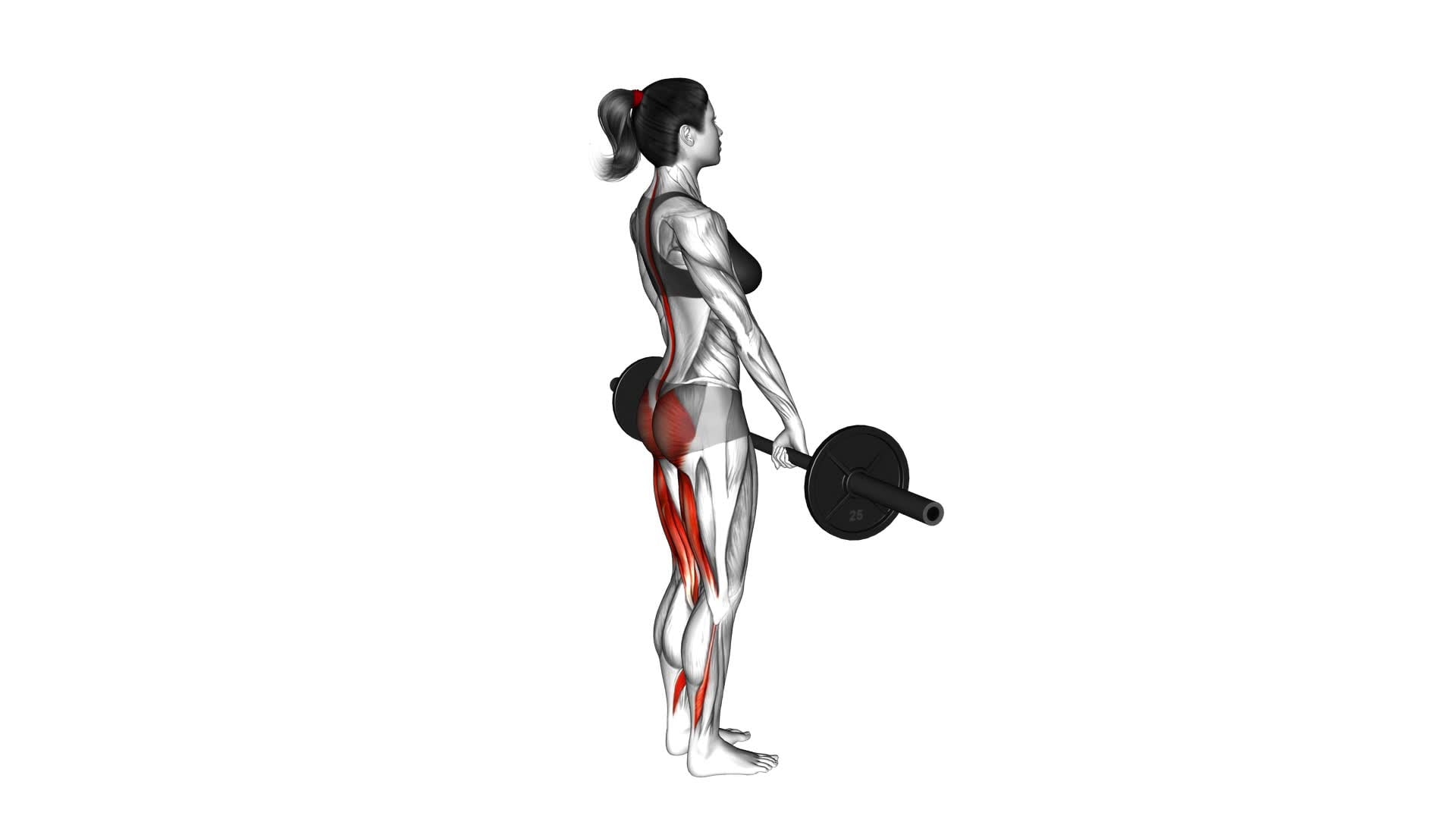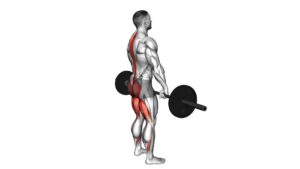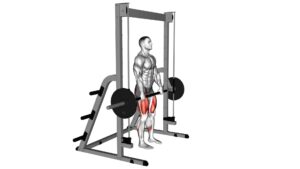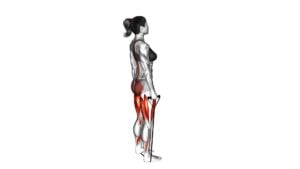Barbell Stiff Legged Deadlift (female) – Video Exercise Guide & Tips

Are you looking to improve your lower body strength and build toned muscles?
Watch This Exercise Video
The barbell stiff legged deadlift is a fantastic exercise for women that targets the hamstrings, glutes, and lower back.
In this video exercise guide, you'll learn how to properly set up and align yourself, execute the exercise with proper form, and make modifications based on your fitness level.
Avoid common mistakes and maximize your results with these helpful tips.
Let's get started!
Key Takeaways
- Targets the hamstrings, glutes, and lower back
- Helps improve lower body strength and muscle tone
- Proper form and alignment are crucial for effectiveness and safety
- Modifications can be made for different fitness levels
Benefits of the Barbell Stiff Legged Deadlift
One of the benefits of the Barbell Stiff Legged Deadlift is its ability to strengthen your glutes, hamstrings, and lower back. This exercise is highly effective in targeting these muscle groups, making it an essential addition to your workout routine. The Barbell Stiff Legged Deadlift offers various variations that allow you to customize the exercise according to your fitness level and goals. These variations include using different grip widths, altering the stance, or implementing pauses at certain points in the movement.
However, it's crucial to emphasize the importance of proper technique when performing the Barbell Stiff Legged Deadlift. Maintaining a neutral spine, engaging your core, and keeping the barbell close to your body are key elements of proper form. Neglecting these techniques can lead to injuries, such as strains or pulls in the lower back or hamstrings. It's advisable to start with lighter weights and gradually increase the load as your form improves and your muscles become stronger.
Proper Set-up and Alignment
Ensure proper set-up and alignment for the Barbell Stiff Legged Deadlift by focusing on your posture, positioning, and form. Proper set-up and alignment are crucial for maximizing the effectiveness and safety of this exercise.
One common mistake to avoid is rounding your back. Make sure to maintain a neutral spine throughout the movement by engaging your core and keeping your shoulders back. This helps to protect your lower back and ensures that the targeted muscles are effectively engaged.
Another mistake to watch out for is bending your knees too much. The Barbell Stiff Legged Deadlift is primarily a hamstring exercise, so it's important to keep your knees slightly bent but not excessively. This allows for proper muscle activation and prevents excessive strain on your knees.
To ensure proper alignment, start by standing with your feet shoulder-width apart and the barbell in front of you, resting against your thighs. As you lower the barbell, hinge at your hips while keeping your back flat and your chest up. Make sure to maintain a slight bend in your knees and keep the barbell close to your body throughout the movement.
Executing the Exercise With Proper Form
To execute the Barbell Stiff Legged Deadlift with proper form, make sure that you hinge at your hips while keeping your back flat and your chest up. This is crucial for maintaining proper alignment and preventing injury. One of the most common errors people make when performing this exercise is rounding their back, which can put excessive strain on the spine. By keeping your back flat, you engage the posterior chain muscles, including the hamstrings, glutes, and lower back, more effectively.
Another common mistake is allowing the knees to bend excessively, which shifts the focus away from the hamstrings and onto the quadriceps. By maintaining a slight bend in the knees and focusing on the hip hinge, you can target the hamstrings more effectively.
Executing the Barbell Stiff Legged Deadlift with proper form offers several benefits. Firstly, it helps to strengthen the posterior chain muscles, which are responsible for hip extension and maintaining good posture. This can improve your overall athleticism and performance in other exercises. Additionally, performing the exercise correctly can help to improve hip mobility and flexibility, reducing the risk of injury in daily activities and sports. Lastly, by engaging the core muscles and maintaining proper alignment, you can enhance core stability and improve overall body control.
Modifications for Different Fitness Levels
When it comes to modifying the barbell stiff legged deadlift for different fitness levels, there are a few key points to keep in mind.
For beginners, simplifying the movements and focusing on proper form is essential.
Intermediate individuals can increase the resistance by adding more weight to the barbell.
Advanced exercisers can challenge themselves with complex variations of the exercise to further engage their muscles and improve overall strength and stability.
Beginner Modifications: Simplified Movements
Start with lighter weights and focus on proper form to gradually build strength and progress in difficulty for the barbell stiff-legged deadlift. As a beginner, it's important to start with equipment options that suit your fitness level.
If the barbell feels too heavy, you can use dumbbells or kettlebells instead. This will allow you to perform the exercise with proper technique and reduce the risk of injury. As you become more comfortable and confident, you can gradually increase the weight and transition to using the barbell.
Another beginner modification is to perform regressions of the movement. Instead of lowering the weight all the way to the ground, you can start by performing the exercise with a smaller range of motion. This will help you build strength and stability before progressing to a full range of motion.
Remember to always listen to your body and make modifications that suit your fitness level.
Intermediate Adaptations: Increased Resistance
As you progress in your fitness journey, you can gradually increase the resistance for the barbell stiff-legged deadlift. This will help you challenge your muscles and continue to make progress.
There are several modifications you can make to increase the resistance of this exercise. One option is to add weight plates to the barbell. Start with a weight that feels challenging but manageable, and gradually increase it as you get stronger.
Another modification is to use resistance bands. Attach the bands to the barbell and step on them to create additional resistance.
To ensure that you're making progress, it's important to track your workouts. Keep a record of the weight you're using and the number of repetitions you're able to perform. This will allow you to see your progress over time and make adjustments as needed.
Advanced Adjustments: Complex Variations
To further challenge yourself and cater to different fitness levels, incorporate complex variations of the barbell stiff-legged deadlift.
These advanced progressions will help you take your workout to the next level and continue to see results.
One option is to perform the exercise on an unstable surface, such as a BOSU ball or a balance disc. This will engage your core and stabilizer muscles even more, increasing the difficulty of the exercise.
Another variation is to use dumbbells instead of a barbell, which will require more control and coordination.
You can also try adding a resistance band around your thighs to add extra resistance and target your glutes.
Remember to start with lighter weights and gradually increase the intensity as you become more comfortable with these complex variations.
Common Mistakes to Avoid
To ensure you perform the barbell stiff legged deadlift correctly and avoid injury, it's important to be aware of common mistakes.
One common mistake to avoid is using incorrect form, which can put unnecessary strain on your lower back and hamstrings.
Another mistake is failing to activate the proper muscles, such as the glutes and hamstrings, which can limit the effectiveness of the exercise.
Incorrect Form Dangers
Using improper form during the barbell stiff legged deadlift can lead to potential dangers and common mistakes that you should avoid. To ensure injury prevention and get the most out of your workout, it's crucial to perform this exercise with proper technique. Here are three common mistakes to avoid:
- Rounding your back: This puts excessive strain on your lower back and increases the risk of injury. Keep your back straight and maintain a neutral spine throughout the movement.
- Using too much weight: It's important to start with a weight that you can handle comfortably. Lifting too heavy can compromise your form and increase the risk of injury.
- Neglecting the hip hinge: The barbell stiff legged deadlift relies on a proper hip hinge movement. Failing to engage your hips and relying solely on your lower back can lead to injury. Focus on pushing your hips back as you lower the barbell.
Proper Muscle Activation
Avoid neglecting proper muscle activation when performing the barbell stiff legged deadlift. Proper muscle engagement is crucial for maximizing the effectiveness and safety of this exercise.
When the muscles aren't activated correctly, it can lead to inefficient movement patterns and increase the risk of injury. To ensure proper muscle activation, focus on engaging the glutes, hamstrings, and lower back throughout the entire movement.
Activation techniques such as squeezing the glutes at the top of the movement and maintaining tension in the hamstrings can help improve muscle engagement. Additionally, maintaining a neutral spine and avoiding rounding or arching the back will further enhance muscle activation and protect the lower back.
Tips for Maximizing Results
Get the most out of your Barbell Stiff Legged Deadlift by focusing on proper form and engaging your muscles throughout the entire movement. To maximize gains and optimize performance, consider the following tips:
- Maintain a neutral spine: Keep your back straight and avoid rounding or arching your lower back. This will help target your hamstrings and glutes more effectively while reducing the risk of injury.
- Control the descent: Lower the barbell slowly and under control, feeling the stretch in your hamstrings. Avoid simply dropping the weight, as this can lead to loss of tension and diminish the effectiveness of the exercise.
- Engage your core: Activate your core muscles by bracing your abs throughout the movement. This will provide stability and support to your lower back, allowing you to lift heavier weights and maintain proper form.
By implementing these tips, you can ensure that each repetition of the Barbell Stiff Legged Deadlift is performed with precision and intention, leading to maximum results.
Remember to start with lighter weights and gradually increase the load as your strength and technique improve.
Frequently Asked Questions
What Are Some Alternative Exercises That Can Be Done Instead of the Barbell Stiff Legged Deadlift?
Looking for alternative exercises to the barbell stiff-legged deadlift? There are plenty of options that can give you similar benefits.
Try the Romanian deadlift, cable pull-throughs, or single-leg dumbbell deadlifts. These exercises target your hamstrings, glutes, and lower back just like the barbell stiff-legged deadlift.
How Often Should the Barbell Stiff Legged Deadlift Be Incorporated Into a Workout Routine?
To ensure maximum benefits, you should incorporate the barbell stiff legged deadlift into your workout routine with the right frequency.
This exercise is great for targeting your hamstrings, glutes, and lower back. It helps improve your overall strength, stability, and posture.
However, the incorporation frequency will depend on your fitness goals and current fitness level. Consult with a fitness professional to determine the appropriate frequency for your specific needs.
Are There Any Specific Warm-Up Exercises Recommended Before Performing the Barbell Stiff Legged Deadlift?
Before performing the barbell stiff legged deadlift, it's recommended to do some dynamic stretches and foam rolling to warm up your muscles.
Dynamic stretches help increase your range of motion and prepare your body for the exercise.
Foam rolling helps to release any tension or tightness in your muscles.
Can the Barbell Stiff Legged Deadlift Help Improve Flexibility in the Hamstrings and Lower Back?
The barbell stiff legged deadlift can greatly improve flexibility in your hamstrings and lower back. By performing this exercise, you'll not only strengthen these muscle groups but also increase their range of motion. This can lead to improved overall strength and muscle development.
To ensure proper form and technique, keep your back straight, engage your core, and maintain a slight bend in your knees. Remember to start with a lighter weight and gradually increase as you become more comfortable with the movement.
Are There Any Specific Breathing Techniques That Should Be Followed While Performing the Barbell Stiff Legged Deadlift?
When performing the barbell stiff legged deadlift, it's important to focus on your breathing technique. Proper breathing can help you maintain stability and control throughout the exercise.
Take a deep breath in before you lower the barbell, and exhale as you lift it back up. This helps engage your core and provide support to your lower back.
Conclusion
In conclusion, the barbell stiff-legged deadlift is a highly effective exercise for strengthening the posterior chain and improving overall lower body strength.
With proper set-up and execution, this exercise can be modified to accommodate different fitness levels. Avoiding common mistakes and following the provided tips will help maximize results.
Incorporating the barbell stiff-legged deadlift into your workout routine can lead to increased muscle tone, improved posture, and enhanced athletic performance.

Author
Years ago, the spark of my life’s passion ignited in my mind the moment I stepped into the local gym for the first time. The inaugural bead of perspiration, the initial endeavor, the very first surge of endorphins, and a sense of pride that washed over me post-workout marked the beginning of my deep-seated interest in strength sports, fitness, and sports nutrition. This very curiosity blossomed rapidly into a profound fascination, propelling me to earn a Master’s degree in Physical Education from the Academy of Physical Education in Krakow, followed by a Sports Manager diploma from the Jagiellonian University. My journey of growth led me to gain more specialized qualifications, such as being a certified personal trainer with a focus on sports dietetics, a lifeguard, and an instructor for wellness and corrective gymnastics. Theoretical knowledge paired seamlessly with practical experience, reinforcing my belief that the transformation of individuals under my guidance was also a reflection of my personal growth. This belief holds true even today. Each day, I strive to push the boundaries and explore new realms. These realms gently elevate me to greater heights. The unique combination of passion for my field and the continuous quest for growth fuels my drive to break new ground.







